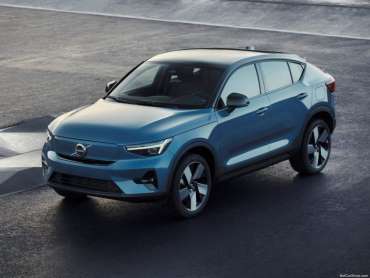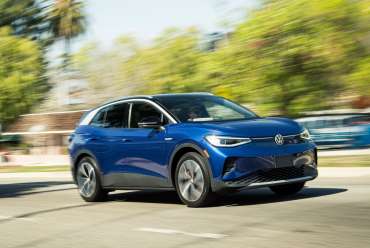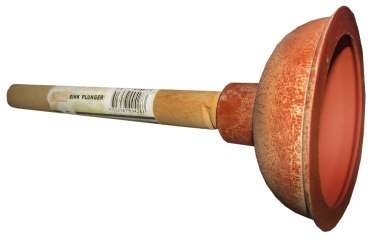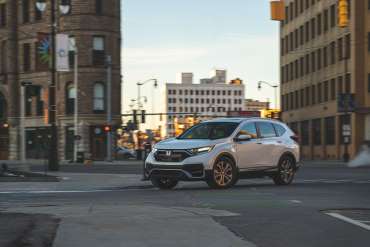
Worldcarblog.com
Check the oil regularly to extend engine life
The oil in the car needs to be checked regularly. It is not good to have too little but not too much oil in the engine. Lack of oil is harmful because a small amount heats up more than the normal amount, and when there is significantly more oil in the engine than the maximum, some of the oil can enter the combustion chamber and the catalyst and lamp tube can be destroyed.
Regular inspection and oil changes have a major impact on engine life. Every engine consumes oil, and some normal consumption is up to half a liter per 1000 km. It is advisable to check the oil on a flat surface when the car engine is off. It is necessary to wait a few minutes after the engine shuts down so that the oil from all parts of the engine flows into the crankcase, and only then can the amount of oil be realistically measured.
When pouring oil, do not overdo it and it is best that the oil level in the engine is between the "min" and "max" marks. When a little more oil is poured into the engine, there is no great damage because it will return to normal in ten hours of driving. However, when significantly more than the maximum is poured into the engine, some of the oil from the crankcase can enter the combustion chamber. There will probably be no major damage to the combustion chamber, but the catalyst and lambda probe may be destroyed.
On the other hand, when the oil level is below the minimum, a defect occurs which is recognized by the lighting of the oil pressure lamp. As we have already mentioned, a deficiency in the engine is harmful because a small amount of oil heats up more than the normal amount. Also, when there is no lubrication, extremely high temperatures develop, and dry friction occurs which causes the metal parts of the engine to melt.
Which oil to choose?
Types of oils for cars can be divided into mineral, semi-synthetic and synthetic:
1) Today, mineral oils are no longer used for new engines, but exclusively for older cars because they do not provide sufficient engine protection against wear. Mineral oils are more used to develop engines after general.
2) Semi-synthetic oils are mixtures of mineral oil as a base and added synthetic oil. Their price is lower than synthetic oils, but they do not have as much temperature and oxidation resistance, and require more frequent changes than synthetic ones because they do not last as long as synthetic ones.
3) Synthetic oils are the highest quality oils, and they are characterized by high resistance in conditions of extremely low and extremely high temperatures. They also protect the engine very well from wear and tear, and it is recommended to use them with turbo engines. These oils are usually the most expensive.
It is recommended to always put the same oil in the car engine, and if you do not know which oil goes in your car, find in the manual for your car which engine oil viscosity gradation is recommended by the manufacturer, and also find the factory specifications for the engine oil.
Lexus UX review
Compact crossover is an intriguing, leftfield choice
Seemingly at a relentless pace, the onward march of the SUV continues, as typified by the Lexus UX crossover. Not so long ago, the RX was Lexus’s only SUV, but in short order the British line-up’s been fleshed-out both by the medium-sized NX and the seven-seater RX L. With the UX, Lexus has a smaller model to entice buyers away from the Audi Q3, BMW X1, Jaguar E-Pace and Mercedes-Benz GLA.
It’s the GLA that this Lexus feels closest to in terms of ethos – while it ticks various SUV styling cue boxes with its unpainted dark grey wheelarch extensions and body addenda, the UX nevertheless feels like more like a tall hatchback than a rugged cross-country vehicle, much like the Audi Q2 and BMW X2.
As a result, Lexus loyalists will likely head to the UX from the ageing CT hatchback, or perhaps downsize from the bestselling NX. In fact, Lexus has such high hopes for the UX that it should become the firm’s most popular model, overtaking the UX. It’s also expected to be the most important model for the brand in terms of getting new customers into the Lexus brand.
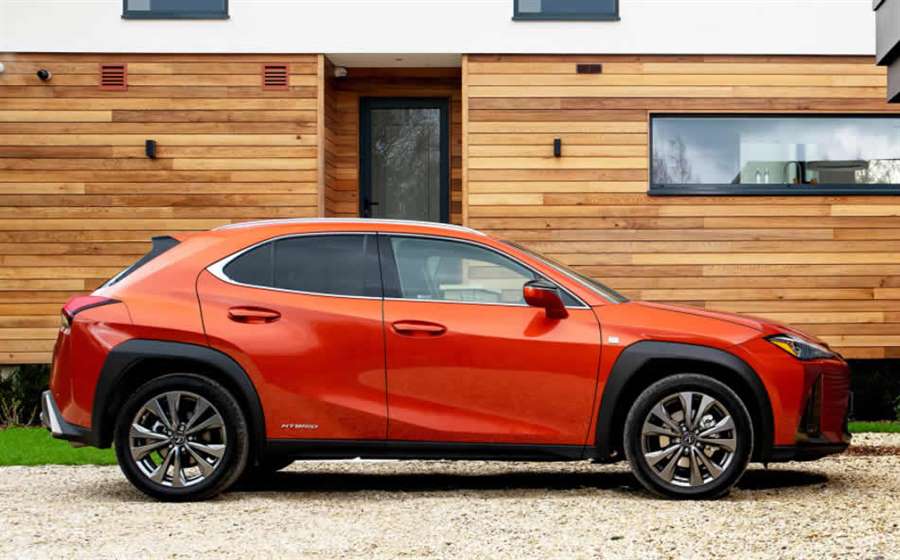
Interior stylish and well made
You won’t mistake the UX’s cabin for the Teutonic look of its Germanic rivals or the so-so quality from its Jaguar Land Rover alternatives – this is undoubtedly a good thing and we like that Lexus continues to plough its own furrow. Material quality, fit and finish is deeply impressive, with a variety of complementary materials giving the dashboard a broad, low, layered look.
Less successful is the continued application of the touchpad for controlling the multimedia system – it’s simply not as intuitive as its rivals’ systems and in some regards is downright infuriating. Still, at least the clock alongside the infotainment screen is a classy analogue number, and not a digital affair shared with a 1980s microwave oven.
Space isn’t the UX’s strongest point however. While there’s enough room up front with an excellent, low-feeling, cocooning driving position, space in the back is no better than adequate. Compared with something like the Audi Q3 which is very impressive indeed, the UX’s sleek roofline and smaller dimensions mean there’s only enough room for two average-height adults. Any taller or wider and you’ll be struggling, especially if there are taller occupants in the front.
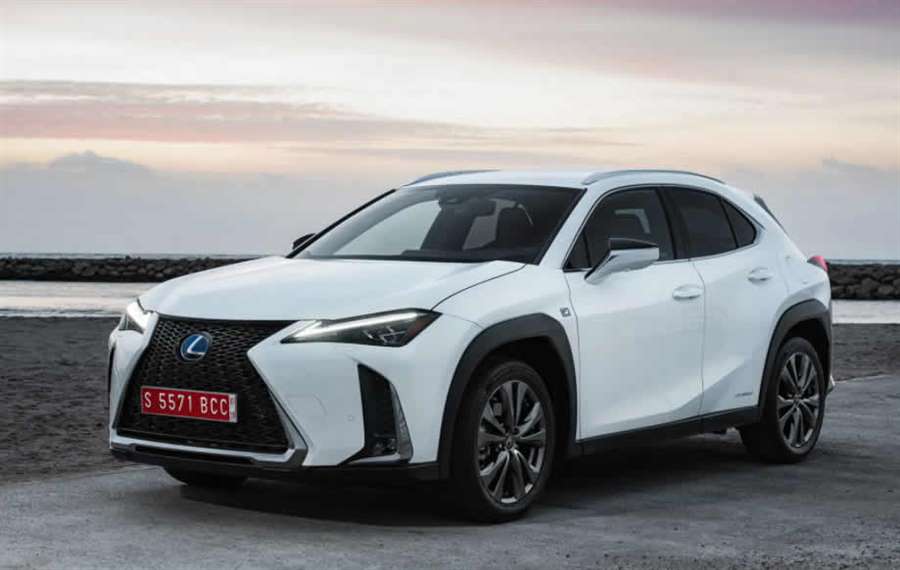
Lexus UX 250h the only engine option
Although a petrol-only UX 200 is available in other European markets, the UK cars will be exclusively hybrid-powered – all models sold in Britain will be badged UX 250h.
Despite the numbering system suggesting otherwise, the 250h is powered by a combination of an all-new 2.0-litre petrol engine, with Lexus’s fourth-generation of hybrid technology. Together they produce 178hp and 202Nm of torque, driving the front wheels. Its top speed is electronically governed to just 110mph, while the claimed 0-62mph acceleration benchmark requires just 8.5 seconds.
There’s also a four-wheel drive version of the UX available – badged E-Four – but this is expected to be a small seller. It also has some practicality issues in that it shrinks the boot down to just 283 litres from 320 litres – no better than a small supermini. Around town, both versions are very civilised and hushed, only getting noisier when you accelerate harder.
It still sounds like the engine’s spinning faster than the rate of acceleration suggests it should be, but this soon subsides. The gentler, more progressive you drive it, the more relaxed it feels. And sounds.
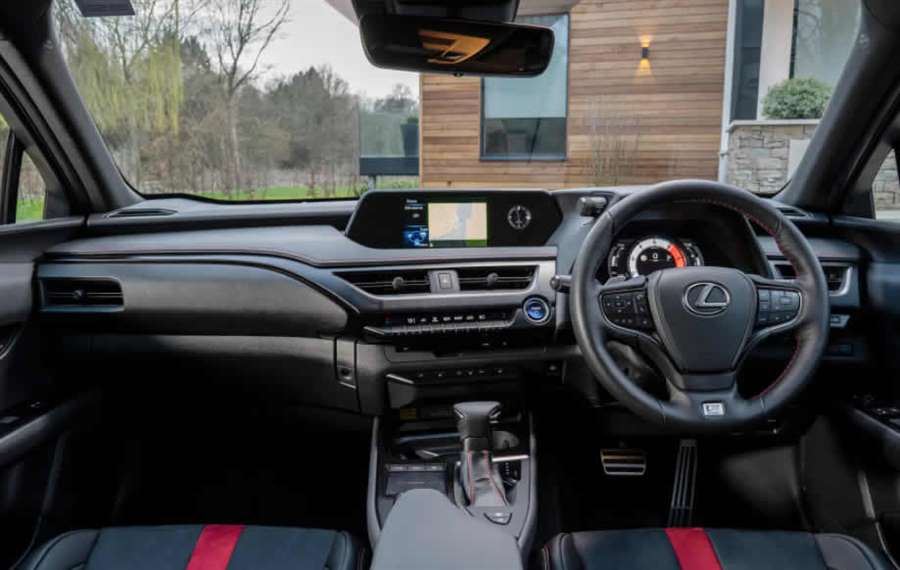
How economical is the UX 250h?
Lexus has yet to confirm the exact fuel efficiency and emissions levels of the UX range, but under the more real-world-imitating WLTP testing method they don’t look immediately impressive. Stick with a front-wheel drive UX 250h and fuel economy ranges between 49.6mpg and 53.3mpg, and claims CO2 emissions of 131g/km.
At the other end of the scale, a UX 250h F Sport E-Four riding on 18-inch rims delivers equivalent figures of 46.3-48.7mpg. Lexus has no immediate plans to release a plug-in hybrid version of the UX – for the time being the 250h is what its manufacturer refers to as a ‘self-charging hybrid’.
Lexus UX practicality and boot space
Lexus’s engineers wanted the UX to have a coupe-like feel and to a certain degree they’ve been successful in this aim, although not always to the benefit of passengers. You sit low down, lowering the car’s centre of gravity, but because the window line is also quite high – you feel more hemmed-in than behind the wheel of a BMW X2 or Range Rover Evoque, for instance.
Space-wise the front chairs have ample room for limbs and heads, and also prove very comfortable – it’s possible to spec them with heater and cooling air conditioning fans. F Sport-spec seats are slightly pinchier at the hips, but in no way uncomfortable. Spare a thought for those in the back, though – it’s not especially roomy and tall passengers will struggle for both head- and legroom in particular. Three adults abreast on the rear bench will prove unpopular and uncomfortable, although the transmission tunnel is quite small.
Even getting in and out of the back seat is a bit of a challenge, with quite a narrow door aperture. Pre-teens aren’t likely to have anywhere near as much bother, and arguably if more space is required, there’s the NX above the UX in Lexus’s SUV hierarchy.
That cosy interior comes partly because the UX is a compact car. It’s smaller than an Audi Q3 – more like the Q2 in size, and as a result is very easy to manoeuvre. Reversing cameras and parking sensors are standard which help, and visibility is good looking forwards and to the sides thanks to slim A-pillars.
Turn around and the angular body work lends a more restricted view out of the back – making it a little trickier to manoeuvre than its Audi rivals. However, those extra assistance systems help to negate this. On the plus side, the UX’s turning circle is nice and tight, so manoeuvring in tight spots is very simple.
Practicality is also hampered in the boot, with a high loading lip and a shallow depth between the boot floor and the flimsy luggage cover. On front-wheel drive models this load level can be lowered to a space beneath, expanding to 320 litres, but it’s very shallow when it’s in place and in line with the loading lip.
Those cars fitted with E-Four come with this as the only boot set-up – the shallow one that even saw a medium-sized holdall digging into the load cover. In this form, boot capacity is just 283 litres which is worse than many small superminis.
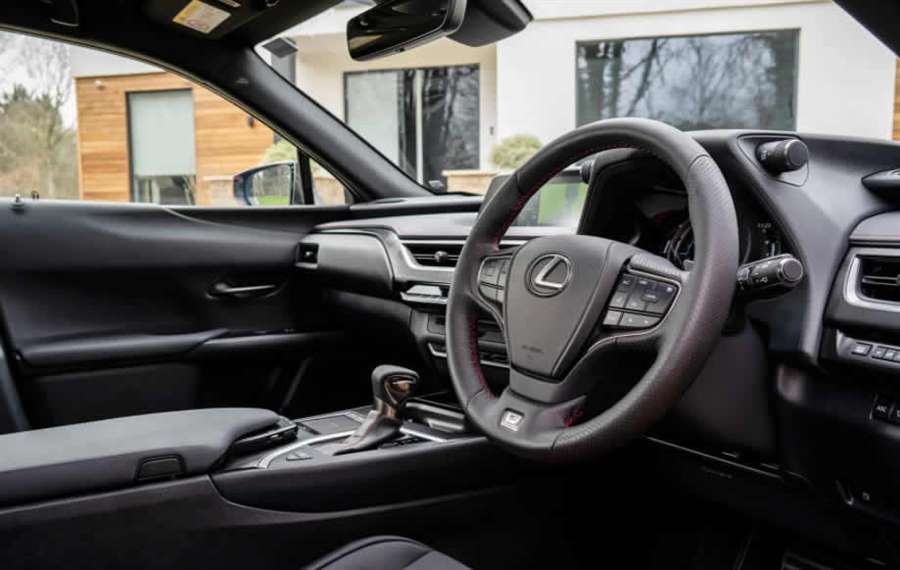
How safe is the UX?
Thanks to standard-fit Lexus Safety System, the UX boasts some impressive safety credentials that have contributed to its five-star rating from Euro NCAP. The suite of driver aids and safety kit consists of:
On top of this, the UX comes with eight airbags, various braking and traction systems, hill-hold assist and the option of adding blindspot monitors and rear cross-traffic alert. For families, there are two Isofix points in the rear as well.
Lexus UX interior and comfort
The design of the UX’s interior matches that of the exterior. There are plenty of varied angles and design features, but we’re pleased to report it’s very high quality with an expensive feel. It’s also less daunting to operate than you might expect, although the media system is a source of frustration like it is in the brand’s other models.
Getting comfortable is very easy indeed thanks to a wide range of seat and steering wheel adjustment. You don’t sit especially high up like you’d expect of an SUV – there’s more of a hatchback feel to the UX. However, you feel hunkered down with the cabin swooping around you, and is a very pleasant place to be.
Whether it’s the seats, the door panels or the top of the dash, the materials used are high quality for the most part, even if there are various different materials and textures used.
Our biggest issue with the interior of the UX – at least in the front – is the media system. The large screen is bright and easy to view as it’s set on top of the dashboard, but the way in which it’s operated is via a frustratingly dim-witted touchpad located on the centre console. It requires greater precision than a rotary controller or touchscreen, and can be quite distracting. The system itself just looks a little dated, too.
Is it comfortable?
The UX may well look like a sharp, sporty off-roader, but the good news is that it doesn’t ride like one. Lexuses are famed for relaxed, comfortable drives – while remaining balanced and composed – and the UX is very much the same.
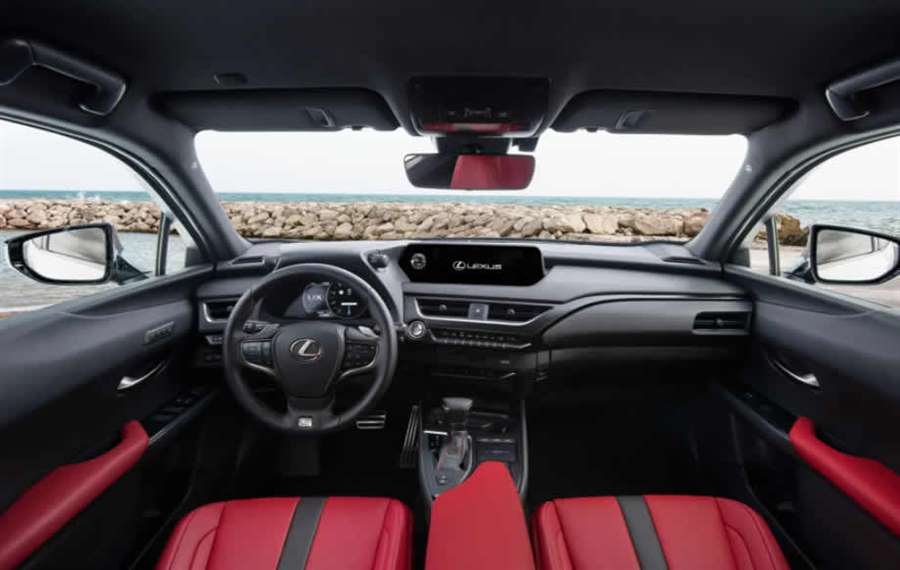
Refinement is excellent which means long journeys are easy and chilled for all, while the seats on all models are excellent. Both supportive in all the right places and very comfortable (with plenty of adjustment) it’s a doddle to get comfy and stay comfy.
Those in the back may find it a bit of a squeeze which impacts comfort levels, but there won’t be too many complaints about the way the UX rides over bad surfaces. Only F Sport models have a slightly more fidgety ride, but even on larger alloy wheels it’s a more relaxed affair than in an Audi Q3 S Line, for example.
Cars fitted with smaller wheels and/or the Adaptive Variable Suspension option offer a very composed ride, with adaptive suspension that is tweaked based on the driving mode you’re in – with a choice of Eco, Normal, Sport and Sport S+. Leave it in Normal for the most relaxed ride.
Lexus UX running costs and mpg
With just one engine available, it’s easy to sift through the UX’s economy figures. For the front-wheel drive model, Lexus claims between 49.5 and 53.2mpg. The lower figure is for cars on smaller alloy wheels.
Go for the E-Four version and there’s only a small penalty – claiming between 46.3mpg and 47mpg.
It shouldn’t be too difficult to get near these figures in everyday driving – as long as you’re not revving the nuts off it.
As with fuel economy, the UX’s CO2 emissions figures are easy to decipher, with just two variants of the same engine.
Tested on the new WLTP emissions cycle, the best-performing UX for emissions comes in at 120g/km, while the worst offender is just over 130g/km – figures that are more than competitive with the majority of its rivals.
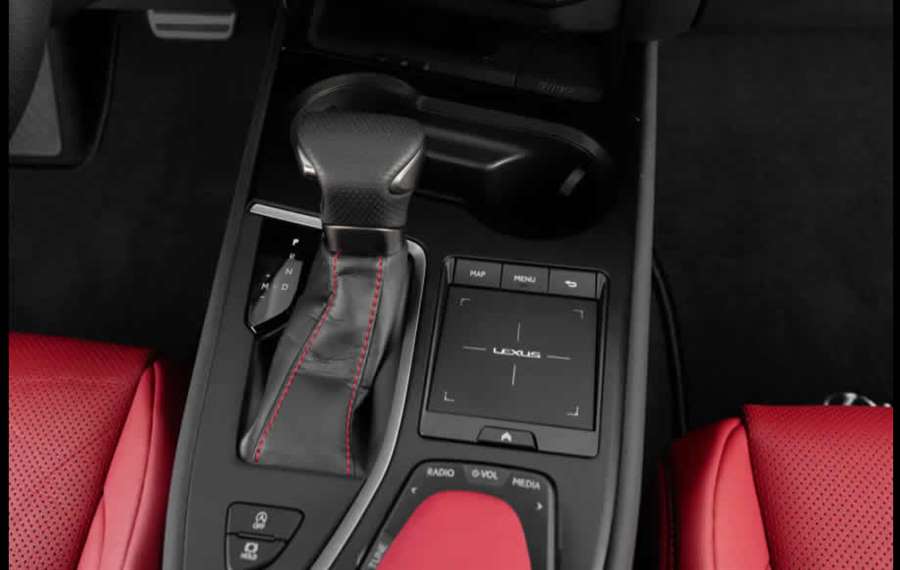
Is it reliable?
Despite featuring a new hybrid powertrain, there’s little reason to expect the UX to be an unreliable car to own. Lexus has a stellar reputation for building cars to very high standards – with some incredible attention to detail that they call ‘Takumi Craftsmanship’. This features things such as windows that slow down before they close to make less noise, and exhaustive testing of the way the doors shut to ensure it’s a solid-sounding noise.
In terms of mechanical components, Lexus has been building hybrids for years, so the technology used should be top notch and very well tested.
Lexus UX engines and performance
Performance is delivered by just one engine – a 2.0-litre petrol hybrid badged UX 250h with 184hp and 190Nm of torque. Lexus describes it as a self-charging hybrid, which basically means you don’t need to plug it in and it sorts itself out which mode it’s in.
The most popular version is the front-wheel drive model, and this will take 8.5 seconds to complete the 0-62mph sprint. Go for the E-Four four-wheel drive model and this drops ever so slightly to 8.7 seconds – largely due to the extra weight it’s carrying around.
In reality, the UX doesn’t feel as rapid as those figures suggest when you floor the throttle. It takes a little while for the engine to get going, but when it does it surges forwards smoothly and without any real fuss. The main thing you’ll notice is the moan from the engine as the revs soar – a characteristic we’ve become used to with hybrid powertrains and CVT transmissions. However it calms down when you’re up to speed, and the UX isn’t the kind of car you’d be thrashing around anyway.
Everywhere else, the comfortable and quiet nature of the UX means it’s very refined and relaxed, while pottering around town allows you to travel for a lot of the time purely on battery power. That means it’s very smooth and silent, with just a little murmur from the engine when it does kick in.
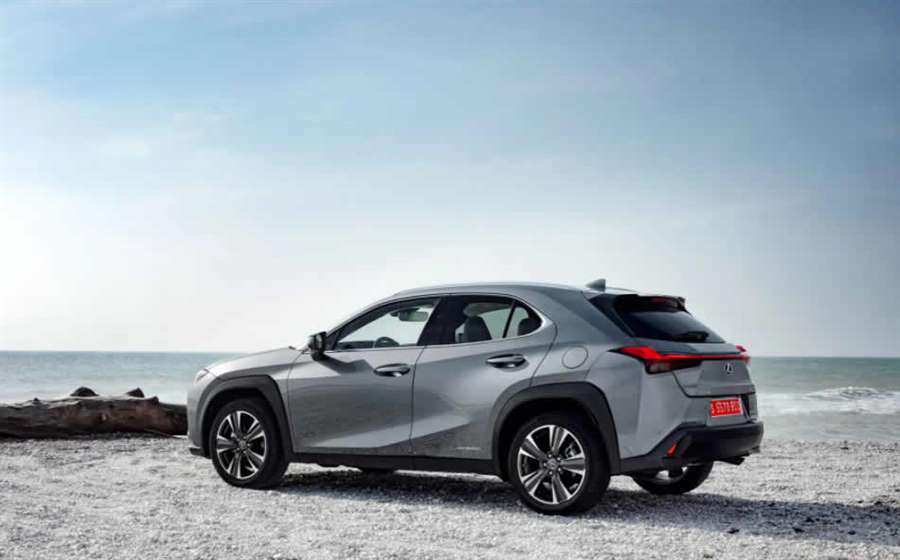
Lexus UX 250h E-Four
The E-Four system directs drive to the rear wheels when it detects the front pair could do with extra traction. Having driven both versions over similar road conditions, we suspect the E-Four package isn’t going to be beneficial to most UX buyers.
Although the UX 250h E-Four has the same top speed as its front-wheel drive sibling (110mph), the extra weight of the system slows the 0-62mph time a shade to 8.7 seconds.
Lexus refers to the hybrid UX’s gearbox as an electronic continuously variable transmission, but it’s not a CVT in the conventional sense – strictly speaking it’s a planetary gear set. Rather than get bogged-down in technicalities, the important thing to know is that it’s less whiny than previous iterations of the transmission.

How does it handle?
The UX performs well around town – the hint is in the name as it stands for ‘Urban Crossover’. It’s very quiet running in EV mode for a lot of the time, but even when it’s not, it’s very hushed. Its small size and tight turning circle make it great for nipping around city streets. Whether you’re in Eco or Normal driving modes, it’s a smooth and relaxed operation.
If you’ve sampled other Lexuses, particularly the CT and NX, you’ll note that the UX’s controls feel weightier. They still feel light around town, but the small amount of extra force you need to haul it about on windier, quicker roads makes it more engaging than its siblings.
While it’s nimble on twisty B-roads, it doesn’t strike its driver as being an athletically enthusiastic sporty SUV. Traction is more than ample – even on front-wheel drive versions – but you don’t find yourself deliberately seeking to carry speed into corners with a view of powering fast out of them – an X1 or an E-Pace perform better in this regard. A lot of this comes because of the hybrid engine that almost holds you back from having too much fun.
F Sport versions of the UX feature larger, 18-inch alloy wheels and stiffened suspension, with anti-rollbars, featuring mid-point dampers to absorb shocks transmitted through the suspension. Over poor road surfaces you’re immediately aware of the firmer compromise – it’s not uncomfortable, and still rides in a far more relaxed manner than an equivalent S Line Audi or M Sport BMW.
Far better to stick with a 17-inch-wheeled UX and opt for the Adaptive Variable Suspension (AVS) arrangement. Here the combination is satisfyingly compliant and seemingly free from uneasy wallowing in corners or under braking. Again, it reinforces that the UX performs more impressively when driven with measured consideration.
Lexus UX long-term test
We ran a Lexus UX 250h for six months, between December 2019 and June 2020. Click the links below to jump to individual monthly reports...
Most car manufacturers are jabbering on about electrifying their model line-ups, some with more ambition than others. But all the while, Lexus has been leading the charge (boo) – offering a hybrid powertrain in every single one of its UK models since 2013.
So while Lexus, or rather its parent company Toyota Group, wasn’t the first to the hybrid game, it’s been the most successful, selling more hybrids than anybody else so far. Yet it’s also proved resistant to change, having yet to launch a plug-in hybrid or pure-electric vehicle and continuing on with what it calls its ‘self-charging hybrid’ powertrain.
To see if it’s still fit for purpose, I’ll be running this for the next six months – a Lexus UX. It’s the smallest SUV in the brand’s four-strong range, and rivals cars such as the Audi Q2, BMW X1 or Volvo XC40.
Self-charging hybrid?
I wanted to tackle this term right away, as it can instil rage into even the most mild-mannered of car enthusiasts online. Type it into Twitter and you’ll find page upon page of not-so-reasoned debate.
Critics say that the term is misleading – it suggests that the car is pulling electricity out of thin air, that it will never need to be refuelled and that all it is is a more efficient petrol car. Toyota says that it addresses buyer’s concerns about hybrid cars – namely, the misconception that you can’t buy one unless you have somewhere to plug it in – and it wants to show that its vehicles do not need external power to perform at their best.
2020 Lexus UX rear three quarter
While I can see where the critics are coming from, I don’t really buy that the average consumer is so thick as to believe the car entirely fuels itself. And though I’m not mad on the term, I can’t really think of a better one that extols the virtues of the powertrain while also communicating that it’s different to a plug-in hybrid.
In addition, I think it's a fairly accurate description. While admittedly all of the power comes from petrol in one way or another, the car charges its battery entirely autonomously - either from the engine or through regenerative braking and coasting.
So there. I’ll be calling this UX a self-charging hybrid throughout these reports. Ner ner ner.
So what’s it actually like?
Superficial things out of the way first – the UX’s design is an acquired taste, but I love the combination of Celestial Blue metallic paint and cream leather that our car rocks. It certainly stands out, with bodywork covered in violent cuts and creases, the aggressive ‘spindle’ grille and a full-width element at the rear providing plenty of interest.
This is a base-spec UX, but it’s fitted with two really important upgrades – the Premium Plus Pack and the Tech and Sound pack. These are pricey options, weighing in at £4,200 and £1,900 – though you can’t have the latter without the former.
2020 Lexus UX interior
They add plenty of luxury kit, though, which I reckon is fairly essential on a premium-badged model such as this. In fact, for the £6,100 total you get 25 new features – not a bad ratio. They include keyless entry, all-round parking sensors, heated and electrically adjustable front seats, 18-inch alloy wheels and privacy glass, which are all useful touches.
Naturally, as a bit of a tech geek, I’m more interested in the wireless charging pad, digital dashboard, head-up display and 13-speaker Mark Levinson stereo system. I can confirm that it sounds absolutely mega.
I’ll admit to being slightly less enthusiastic over the prospect of six months with Lexus’ infotainment system. More on that in a future update, but for now, all you need to know is that it took three fairly experienced automotive journalists around 10 minutes to figure out how to turn the sat-nav’s voice commands off.
Our UX also lacks Apple CarPlay and Android Auto, though there’s great news on that front – 2020 model year cars come with the software installed, and it’s an upgrade that will be applied to our car at its next service. Toyota Group has dragged its heels on this smartphone integration for years, and it’s fantastic to finally see it become available.
Speaking of service, Lexus has supplied us with a car with a few thousand miles on to begin with – it’ll require a trip to the dealers during our term with it. This is great, because it means I’ll get to experience Lexus’ legendary service department first-hand and see if it really does live up to expectations.
Any other disappointments?
I’m a bit miffed that this base-spec model still uses halogen bulbs for indicators – they rather spoil the futuristic aesthetic Lexus is going for with the styling, and I think it’s stingy given this car’s near-£30,000 starting price.
Practicality has already proven an issue. The boot is unbelievably shallow, to the point where even a standard-sized bag of shopping pushes into the parcel shelf. The official figures list the boot space as more than 300 litres, which I take with a grain of salt – there’s certainly less usable space in there than in most superminis or even city cars. It’s not a patch on the likes of the Volvo XC40.
The powertrain is often a sticking point with Lexus hybrids – some love its relaxed nature, others find the sometimes unpredictable nature of the transmission a bore. I’m beginning to lean more towards enjoying it, but there are still times when I yearn for the more enjoyable performance you’d get from a similarly powerful turbocharged petrol engine.
First impressions
I’ve gone through just shy of 1,000 miles over my first month with the UX – a mixture of short runs to and from work and longer cross-country trips. It’s given me plenty of food for thought, but overall it’s proven a surprisingly likable car so far.
But watch this space for greater detail, as there’s plenty more to dive into during our six-month term.
Update 2: Performance and handling
Lexus is a brand known for comfort, stunning build quality and impeccable customer service. That’s not to say all of its models are sedate hybrids, though – cars such as the LC, RC F and even the LFA prove that Toyota’s luxury arm can do ‘exciting’ when it puts its mind to it.
So, did any of that expertise get called up when Lexus put together the UX? After all, small SUVs – especially fashion-led ones like this UX – are bought by young, vibrant types... in theory. Certainly from my perspective, as a single 26-year old (albeit somewhat lacking in vibrancy), I'd like a car that's good fun to drive. And happily, I can report that, within its own confines – being a hybrid, automatic SUV – the UX is pretty good.
How good can a self-charging hybrid SUV with a CVT actually be?
It’s all about driving within the car’s limits. Put your foot down all the way and you’re in for a rough time. The continuously variable transmission sends the revs spiking as the engine desperately spins up to try and conjure some forward momentum. You could even flick the car into Sport mode and take control of some artificially created gear ratios. But once again, this is a practice full of sound and fury, signifying nothing.
Instead, I’ve found the ideal level of throttle input. Place your foot at about 70% and the electric motor and petrol engine work in sync to bring progress that’s genuinely rapid, yet refined. It’s rather like riding the wave of torque that you get with a diesel, but without the associated tractor-like thrum.
In fact, it’s rather easy to trivialise the fact that the UX really is quite a quick little thing. At full chat, 0-62mph comes about in just 8.5 seconds – the same as an Audi Q2 35 TFSI. Not too long ago, that would have been considered hot hatchback pace.
Hybrid handler
The UX certainly doesn’t handle like a hot hatchback, but that doesn’t mean it’s not good fun. It’s remarkably poised in the corners, and you can carry a fair degree of speed without the car feeling as though it’s on the edge of disaster.
The rear end in particular feels surprisingly communicative – a surprise, for a small SUV. As ever, the steering’s remote and over-light, but that’s par for the course among this car’s competitors.
Relaxed manners make cruising a pleasure
Yet the UX doesn’t encourage spirited driving, and so my average pace has steadily dropped back. I still keep up with traffic, but this car benefits more and more the smoother your inputs become. Drive it carefully and you’ll see the little ‘EV’ symbol light up on the dashboard, signifying that the petrol engine’s been switched off and, for this limited period, you’re not using any fuel at all.
In fact it’s immensely satisfying to see how often, and how long I can get the EV light to stay on for. There’s a knack to it – you need to lift off the accelerator just enough, as if you were encouraging an automatic car to shift into a higher gear. The last mile or so of my commute is a straight 30mph cruise through my village, and I’m now capable of doing this reliably on electric power alone. So it’s disappointing that, despite all this battery-powered motion, I’ve yet to crack 46mpg since the impressive first month…
Surprisingly for a hybrid – and I say ‘surprisingly’ because these powertrains are usually at their best around town – the UX is a pleasure to drive on the motorway. The engine has more than enough poke for overtaking at faster speeds, wind, road and engine noise are all well-contained, and the supple ride glides over all but particularly rough surfaces.
The adaptive cruise control and lane-keep assist functions aren’t quite as slick as they were on my previous long-termer, a Honda Civic, though. The cruise control is particularly easily perturbed – even with the following distance at its closest setting, it panics and slows the car down long before I get anywhere near the car in front. The lane-keeping aid, meanwhile, tends to spend all its time twitching the wheel, which is very tiring. I’ve had these both switched off for a while in favour of driving ‘analogue’.
Fuel economy: 45.8mpg
Update 3: A mid-pandemic service for our Lexus UX
In line with COVID-19 lockdown regulations (and acknowledging that my job here at Parkers, while important, doesn’t make me a key worker) I’ve been hiding out in my spare bedroom for the last six weeks, working from home and allowing my long-term Lexus UX to gather dust outside but for a weekly trip to the supermarket.
Lockdown couldn’t have come at a worse time either, at least where the car is concerned. It was due its first service, at 10,000 miles or one year old – and I’d just booked it in for March 25 when the country locked down, on March 23. Bugger.
Of course, a short delay on a service interval is hardly a big deal. This is pre-emptive maintenance rather than a particular necessity, and it’s a very badly built car that will go bang if it misses a single scheduled service. The vast majority of car manufacturers have in fact extended their service intervals for the duration of the lockdown period, promising that drivers don’t need to worry about voiding their warranty for missing a scheduled service.
This act has the additional benefit of freeing up space in service bays for key workers – those still working who may need to drive, and for whom a well-maintained car is particularly important.
Some free slots for service still available
Still, I can only assume that the technicians at the Lexus dealer were twiddling their thumbs, because they called me offering a service slot, should I want it. They stressed that I didn't have to take it, though. Toyota's official stance is it will take a 'sympathetic and flexible' approach to servicing during the pandemic - and if I had concerns, I could delay the service.
I accepted, however, for a few reasons. First, and very selfishly, I desperately wanted to get out of the house – having been cooped up alone for almost two months, the deep but one-sided conversations with my dishwasher were beginning to wear rather thin. Second, I was very encouraged by how seriously Lexus was taking cleanliness and social distancing protocols.
And finally, I intended to sign up to the next wave of NHS volunteers, having already used the car to deliver a few lots of groceries around town – and didn’t want the excess mileage to be a problem.
It’s strange how unnatural driving feels, when you’re back at the wheel for the first time in a while. The trip to my ‘local’ dealer in Cambridge (I live 40 miles away, but my nearby Toyota dealer won’t touch Lexus) took a good hour, and felt deeply weird until I got my head wrapped back around the sensation of speed. It was as uneventful as you’d expect, the UX proving as comfortable and refined as ever.
Social distancing like a pro
Lexus was operating service slots in 15-minute intervals to prevent customers from coming in contact with each other. There’s zero contact with the staff, either – I was invited to sanitise my hands and my car key before placing the latter into an envelope and leaving it on the table. I then collected another envelope with the keys to my courtesy car: another UX, freshly sanitised. Returning was the reverse of this.
The process was quick and reassuring, and though there’s no way to totally mitigate the risks of this virus the procedures in place certainly go a long way to minimising it.
As expected, no warnings were thrown up from the service. All went ahead as planned, with the exception of one thing – I’d been assured an update for the infotainment system would be available, adding Apple CarPlay and Android Auto to the UX’s central screen, but this didn’t materialise. It’s a shame, as the drive reminded me how sub-par Lexus’ system is. Even my courtesy car, fitted with an upgraded setup and a larger, higher-resolution display ran the same awkward system, making it no easier to use.
However, as a first-time recipient of Lexus’ legendary customer service, I was left very impressed. Hopefully the next time we meet won’t be under pandemic conditions…
Fuel economy: 43.5mpg
Update 4: Practicality
One of the key factors that appeals to buyers when opting for an SUV is the promise of space – lots of room in the back seats and in the boot, especially compared with an equivalent hatchback. That’s why in many cases they’ve replaced MPVs in manufacturer line-ups.
Lexus has never sold an MPV in the UK, though, and while many of the brand’s larger cars are immensely practical it’s not a particular brand hallmark in the way it is with, say, Honda or Skoda. Despite this, the UX still falls some way short of the practicality I’d hope to find on a car such as this.
Cramped in the back
Front seat passengers are treated very well, but space in the back is a little more limited. There’s sufficient knee and head-room for adults, but four six-footers will definitely feel cramped. That’s a complaint we can make about the majority of compact SUVs, though.
What makes the UX especially bad, however, is the uncomfortable centre perch, and the high window line and aggressively tinted rear glass that make it very dark and cave-like in the back, despite our car’s light leather.
Passengers have also made a curious complaint – that the subwoofer for my car’s (wonderful) Mark Levinson sound system reverberates through the seat, buzzing against their backs and making even short journeys incredibly irritating. I can’t say it’s an issue I’ve experienced myself, even on the few journeys I’ve spent as a rear-seat passenger – but it might be something to consider if you’re buying this car with the intention of regularly transporting people in the rear.
Any issues with the rear seat pale in comparison to those with the boot, though.
Boot? What boot?
The UX’s boot is laughably shallow, to the point it would probably stop me – even with my limited demands on a car’s boot – from buying one. Overall boot capacity is just 320 litres – smaller than a lot of superminis, and much smaller than the 470 litres of a BMW X2 or 405 litres of an Audi Q2.
It’s a long, wide and flat space, but there’s so little space underneath the parcel shelf that even a small bag of shopping ends up squashed.
That must be why Lexus opted to fit a flexible, fabric parcel shelf, rather than a rigid one. This conforms itself to whatever’s placed under it, though, leaving a rather unsightly bulge in the rear-view mirror…
The big problem is that Lexus was forced to fit the car’s standard 12V battery back here. It sits just behind the rear wheelarch, and artificially raises the boot floor to this insane level. As a side benefit, you do get a reasonably-sized hidden area underneath the boot floor, but I’d trade that in for more overall height.
At least the seats fold easily and lay almost completely flat, so it’s not as awful at the trademark IKEA run as it could be.
Is it really a problem?
Limited rear-seat room can be disregarded for a lot of small premium cars like this, as they’re often bought by single people or couples who value style over space. The boot, however, is ridiculous – even a supermini can accommodate a weekly shop for two without needing the parcel shelf to be removed.
It’s certainly a feature I’d recommend looking very carefully at before opting to purchase the UX.
Fuel economy: 45.1mpg
Update 5: interior & technology
I have a pretty extensive mental list of things in a car’s interior that I enjoy, and things that annoy. Like one of those couples on Escape to the Country who demand six acres and a large characterful kitchen-diner, I’m looking for a few specific items – but can be easily put off by an avocado bathroom suite.
The first is the seats. I like long seat bases to support my long legs, plenty of back support – but not too huggy around the thighs. Tick, tick, and a big Lexussy tick here – the UX, like most Lexuses, has fantastic seats. They’re superbly comfortable and very supportive.
Dials and gauges can make or break a car’s interior. After all, nobody wants information overload, but at the same time it’s tiring to be forced to scroll through multiple sub-menus just to see your remaining fuel, for example. Here’s another area the Lexus does well – its dynamic, part-digital dials show plenty of information, with a small panel off to the side which holds driving data. It’s easy to navigate and attractive to look at. Top work.
You’d hope for excellent build quality with Lexus, and I’m happy to report that even on the little UX everything feels well screwed together with no squeaks, rattles or buzzes at speed.
I’m not one to get dewy-eyed over soft-touch plastics, but the Lexus uses them where it makes sense – with all the places you touch being cushioned and pliable, while surfaces lower down the dash are less so.
Tech all works well
My UX is a base model, but one that’s fitted with the Premium Plus Tech and Sound pack. This brings loads of stuff I reckon is essential if the UX is to compete with cars like the Mercedes-Benz GLA or Audi Q2. Electric adjustment and heating for the front seats, keyless entry, all-round parking sensors should, I think, be standard equipment anyway – while the leather upholstery, high-powered Mark Levinson stereo, head-up display and wireless charging are all nice extras.
The stereo in particular sounds excellent, with deep bass, great clarity and more volume than is strictly necessary. It’s a shame that the infotainment system it’s attached to is so rubbish, though – playing music through Bluetooth feels mighty old-fashioned when competitors allow you to connect Android Auto and scroll through to your heart’s content.
Anything you’re missing?
Well, the 7-inch infotainment screen looks a little bit lost in its surround. Higher-end UX models have a 10.3-inch screen, which means the housing has to be able to accommodate that larger unit. As a result, my car has some rather ugly bezels either side and with the text-heavy interface it can be confusing to navigate.
A 360-degree camera would be nice, but the standard rear-view unit works just fine – no need to upgrade as far as I’m concerned. What I do miss is the more sophisticated LED headlights with adaptive high beam – they might illuminate the road slightly more impressively than my car’s basic LED units, which have a very sharp cut-off.
What I’d really like, though, is for Toyota to take the infotainment display from its facelifted C-HR and plop it into the UX. I’ll speak a bit more about the relationship these cars share and which comes out on top in my final update, but in terms of tech the Toyota is leagues ahead thanks to its provision of both a touchscreen and Apple Carplay/Android Auto connectivity.
Fuel economy: 45.0mpg
Update 6: Farewell
After six months and a few thousand miles in the Lexus UX, it’s time to wave goodbye – and collect my thoughts on the time I’ve spent with this premium, hybrid SUV. This obviously wasn’t the typical long-term loan, as it was punctuated in the middle by a nationwide lockdown period. But I handed the car back with plenty of opinions – mixed ones – which I’ll attempt to share now.
Overall? I really like the UX. It’s not quite my favourite of the Lexus lineup – that honour goes to the LC, followed by the RX, because deep down I’m a fancy gal trapped in the body of a cash-strapped journalist. Yet even the UX’s status as the baby of the range doesn’t make it feel in any way budget. Little touches, like the soft-close electric windows, the sumptuously supple leather, the intricate analogue clock on the dash – none of them are what you’d call essential, but they elevate the UX above a similarly-sized offering like the Volkswagen T-Cross.
Looks don’t fade
Divisive – yes. But the UX still looks fresh and I think it’s a particularly smart addition to this market sector.
Lexus UX rear cornering
At night, things only get better. I love the lighting signatures on this car – they’re unmistakably Lexus, yet different to the rest of the range. Full-width taillight elements are becoming more commonplace, but the UX has a particularly clean example. You’ll definitely know if you’re following one of these home.
Great to drive – with caveats
I don’t think the self-charging hybrid system is for everybody. Mechanically involving it is not – even less so than a conventional automatic, so if you like to feel as though you’re innately connected to your car, a Lexus hybrid is not for you. Try a Porsche Macan, or something with a manual gearbox.
But it didn’t take long for me to get used to how the UX proceeds along the road. The electric motor, continuously variable transmission and engine have a pretty harmonious relationship; certainly, some time spent in other manufacturer’s hybrid models has given me new appreciation for how Lexus has tuned its self-charging hybrid system.
It shouldn’t be surprising, really, as parent brand Toyota has been building hybrid cars for more than two decades now…
Practicality still a problem
Truly, the size of the boot was my biggest issue with the UX. I’ve already had a long moan about it above, so I won’t go into it too much here, but I reiterate – any car, even the sportiest of roadsters, ought to be able to cope with a midweek shop for two people. A compact SUV? Well, the bar’s set even higher.
Having normal-sized shopping bags distending the flexible parcel shelf and spoiling rear visibility is something that never stopped grating on me, especially during lockdown when a trip to the supermarket was the only time I drove the car at all.
How much did it cost to run?
Here’s another area the UX left me disappointed – its fuel consumption. I’ve spent plenty of time in Toyota hybrids before now, and I’ve always been incredibly impressed at their economy. A long weekend in a Toyota Corolla 1.8 Hybrid once saw me average over 65mpg with ease – the beauty being that, unlike a diesel, that economy figure is possible even on short journeys.
Lexus UX driving modes
Yet in the UX I’ve never exceeded the 47.9mpg I got during my first month with the car, and over my months it’s averaged out to just 45.5mpg. With official WLTP figures for my two-wheel drive model being a claimed minimum of 49.5mpg, I’m a little disappointed – and I’m certainly no lead-footed speed freak. During its worst month, where a slightly quicker colleague borrowed it, the UX returned just 43.5mpg.
But overall, how does the UX stack up to a closely-related model? Well, that’s where things get awkward, because you see…
I’d rather have a Toyota C-HR
At launch the Toyota C-HR was only available with a rather asthmatic 1.8-litre self-charging hybrid powertrain, so it took until the facelift and the introduction of a 2.0-litre alternative to become a rival to the UX.
After sampling the two back-to-back I have to admit the C-HR is a better car. Though its powertrain is very closely related to the system in the UX, the difference in response is remarkable. The C-HR has a genuine degree more immediacy when you pull away – its handling is keener and its steering rack quicker, too.
You don’t lose much in comfort, either, and the C-HR’s boot is enormous compared with the UX.
The C-HR doesn’t have anything like the interior ambiance that the UX enjoys, but it’s still neatly designed and laid out and – joy of joys – it has Apple CarPlay and Android Auto built in. That’s something new UX’s do get, but the update to install it to my car wasn’t ready before I had to hand it back.
Final thoughts
The UX is good-looking, has a cracking interior, is superbly comfortable on a long journey and is even reasonably good value considering the kit that’s on offer – once you choose a few carefully considered options packs, that is.
Is it worthy of converting buyers of premium German SUVs, such as the Audi Q3, BMW X1 or Mercedes-Benz GLA? I think it is, but whether those drivers would even consider a Japanese car with the quirks of the UX over its Teutonic competition is perhaps unlikely.
Lexus UX front three quarter
I still recommend taking one for a test-drive, though. You never know, you may be drawn in to the world of Lexus – a place where dependability and customer service rule the roost. It’s this, rather than the car itself, that would tempt me into Lexus ownership.
Fuel economy: 45.4mpg
Total average: 45.5mpg
Lexus UX verdict
If practicality is at the bottom of your list of priorities, the Lexus UX is more than worthy of a place on your shopping list if you want something smooth, relaxing and easy to drive that also has some character. It looks great, the interior is plush, interesting, packed to the roof with equipment and has an excellent driving position. It just feels different and a bit special – especially compared with the competition.
While the sole engine option may limit its appeal, the hybrid drivetrain is refined and relaxing around town – which is also where it’s most efficient. The added bonus is that the UX is really quite fun to drive with agile handling and responsive steering, plus it can get up and go if you need it to without fuss and drama.
The Toyota C-HR comes with the same powertrain, though, and costs less to buy and has a bigger boot. It's also just as distinctive to look at and be in. If you want something that's a bit more family-friendly, an Audi Q2 or BMW X2 could be worth a look, but you won't find a hybrid option in either of these ranges.
The new electric Volvo and the announcement of the end for petrol and diesel
After Jaguar Land Rover, Bentley, GM, Ford and others, Volvo has now announced that from 2030 it will produce exclusively electric cars. That's why they accelerated a bit, so today the second electric model of the company was shown - C40 Recharge.
Moreover, the Swedish brand plans that from 2025, half of the sold Volvo cars will be powered by electricity, and the other half by hybrid drive.
This means that in just four years, they will stop selling models powered exclusively by SUS petrol or diesel engines. And whoever decides to buy a new Volvo in ten years, the only models that will be available will be electric.
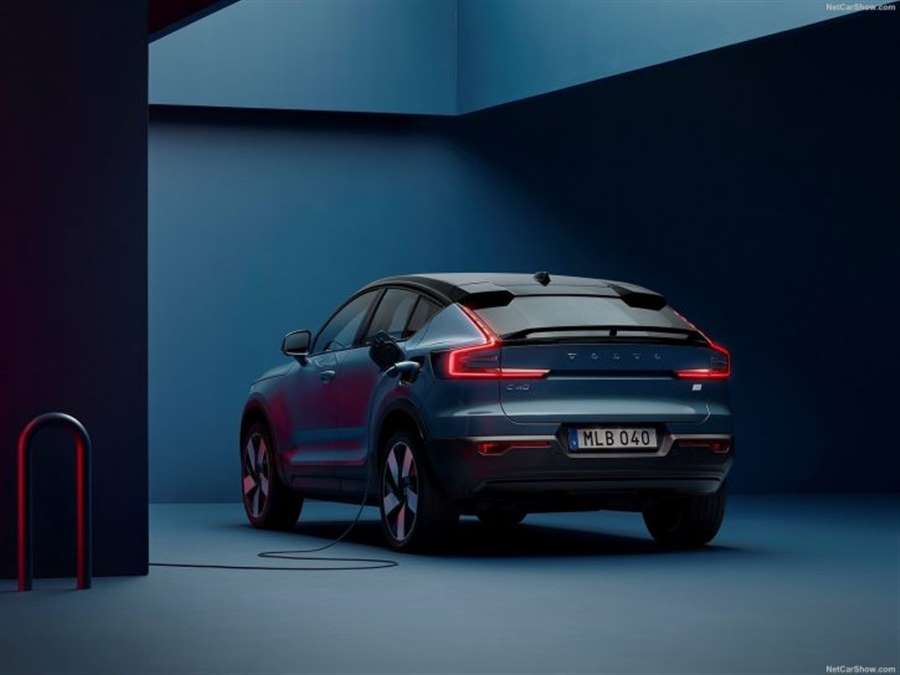
Volvo is owned by the Chinese company Geely, from which it has been confirmed that the conventionally powered models will be on sale only for a while longer, all in order to meet the stricter standards on harmful gas emissions, writes CNN.
It will be a very difficult task for a company that literally has 2 electric cars as of today - the famous XC40 Recharge and the C40 Recharge introduced today.
The new coupe-SUV is based on the XC40 Recharge model, but is slightly lower than it. In addition to a more attractive design, it also has two powerful electric motors with a total power of 408 hp. The 78 kWh battery provides a range of about 420 km, and a charging time of up to 80% is 40 minutes. The new electric model will cost just over £ 50,000.
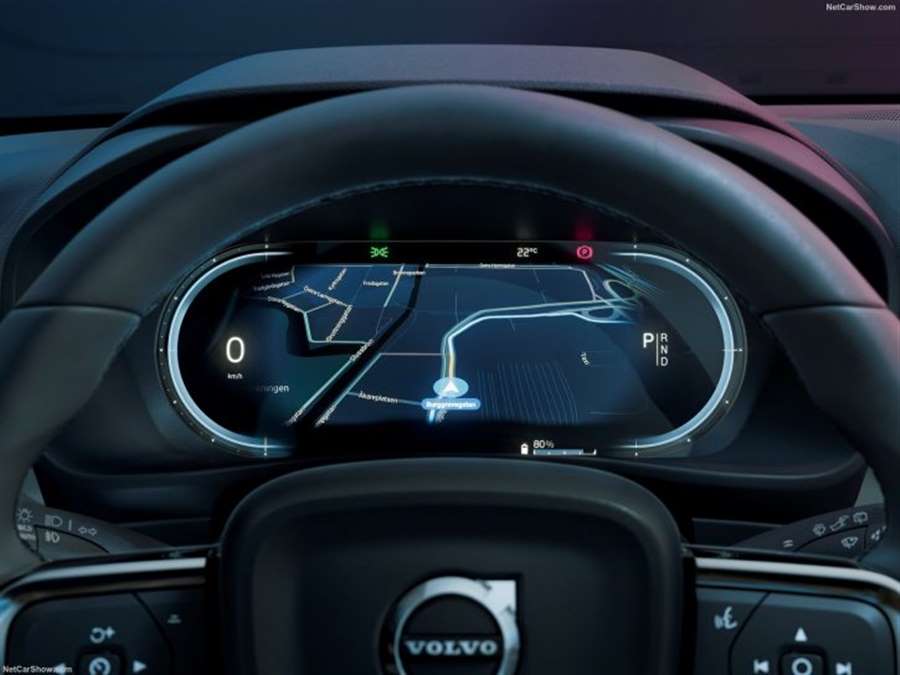
The head of Volvo announced that in addition to the new electric model from the 40 series, more novelties will arrive in the years ahead. As they pointed out from the Sino-Swedish company, they will work a lot on the development of the autonomous driving system.
Another interesting fact that they made public is that the new electric Volvo cars will be sold exclusively online, which already applies to the new C40 Recharge. Investing in online sales will further reduce costs, and after all, a similar strategy is being implemented by Tesla, whose models are officially sold exclusively online.
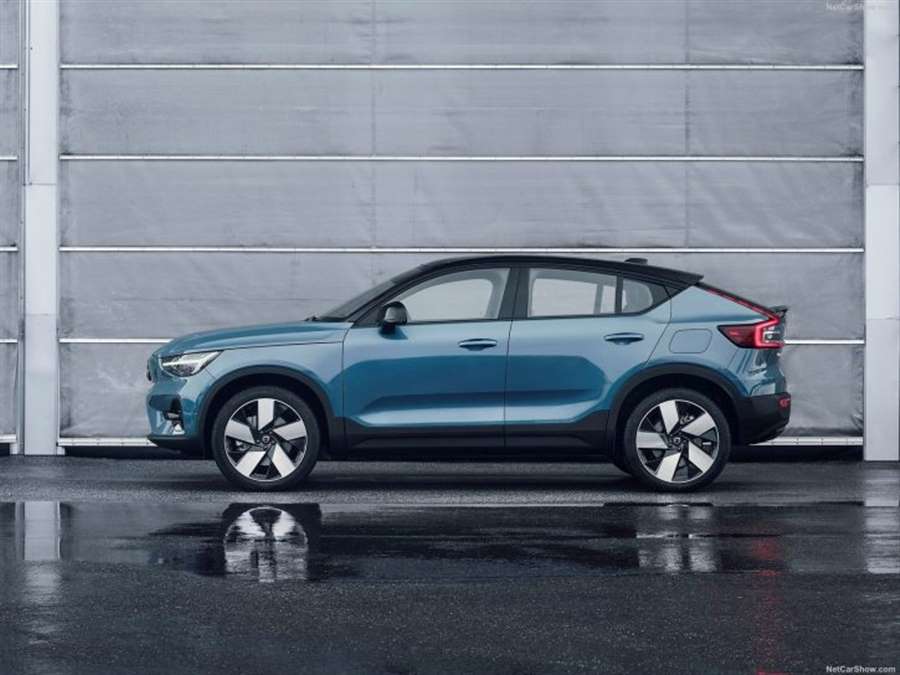
We remind you that many other car companies have recently started announcing plans for a significant acceleration towards full electrification of the market in Europe.
Among them are Daimler, Ford (which will cooperate with VW), JLR and others, while Tesla's first factory in the EU, which is being built in Berlin, will also contribute to this trend.
Also, it is expected that the production of electric cars will be cheaper compared to conventional ones, both due to the new generations of batteries and the smaller number of parts that would be transported and, therefore, the smaller number of workers needed for assembly.
Tested: 2021 Volkswagen ID.4 Seeks to Normalize Electric Cars
VW's electric crossover succeeds at imitating the gas-powered competition but forgoes many of the things we like about EVs.
As electric cars begin to proliferate, we are seeing the auto industry figuring out the best way to build and sell battery-powered cars. Some take existing gasoline models, rip out their powertrains, and bolt in battery packs and electric motors. A few existing carmakers have started new EV-only brands to market purpose-built electrics. One brand is courting the attention and controversy that comes from putting a famous pony-car nameplate on an electric car. And then there are the startups whose big promises are only outdone by the cultlike devotion of their fans. Against this backdrop, VW's approach for the new ID.4 looks extremely logical and straightforward. The 2021 ID.4 is designed and engineered to be an electric crossover that matches the specifications, performance, and character of the best-selling gas vehicles in the United States: compact SUVs such as the Toyota RAV4 and Honda CR-V.
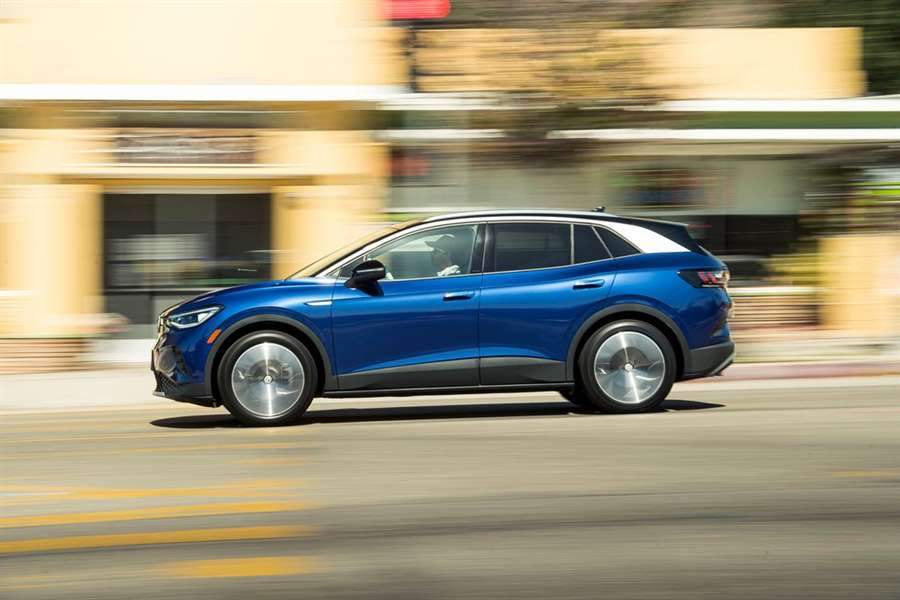
Built on the VW Group's new MEB modular EV platform, the ID.4 has a 77.0-kWh lithium-ion battery pack under the floor and a 201-hp electric motor on the rear axle. While this layout is unusual for the compact crossover-SUV segment, the ID.4's dimensions make it a lot like the rest of the class. The VW's wheelbase is longer, but its length and width are within fractions of an inch of the RAV4's. The ID.4's design hardly advertises its electricness and isn't any more eye-catching than your average crossover. It's shaped like a two-box blob with conventional-looking headlights and taillights. The only bits of flair are in the grilleless face and the optional contrasting C-pillar trim.
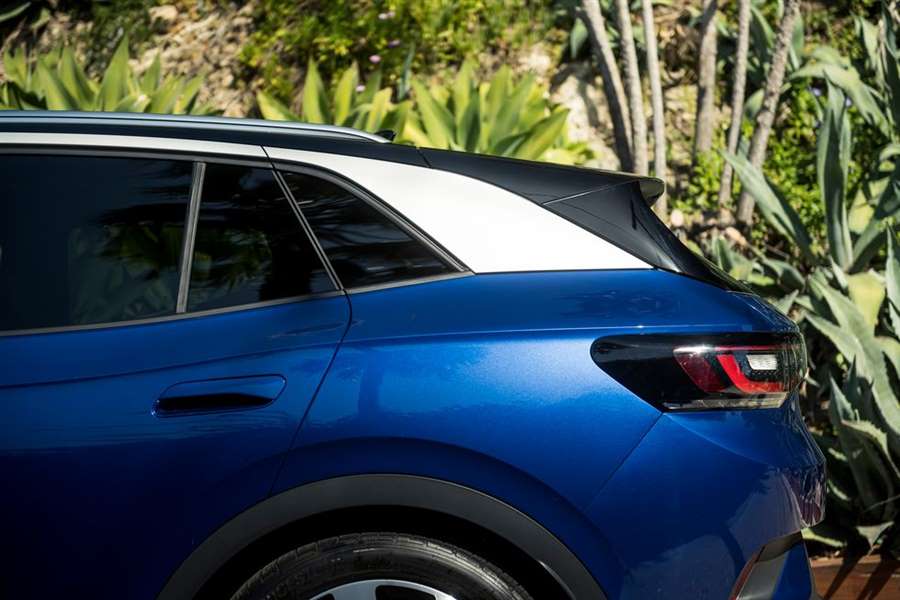
HIGHS: Spacious interior, comfortable ride, quiet at speed.
The ID.4's primary controls are set up to mimic the experience of a gas-powered car. Sit down, turn a knob to put it in Drive, and you won't have to make any adjustments to your driving behavior. Let your foot off the brake and it creeps forward just like a gas car with a torque-converter automatic transmission. Lift off the accelerator and it continues to coast like a gas car with an automatic.
To get more braking from the electric motors requires putting the car into its "B" setting, but even in that mode the regenerative braking effect isn't aggressive enough to reliably slow the car with a lift off the accelerator or to bring the ID.4 to a complete stop. Volkswagen promises one-pedal driving in B mode, but our regular use of the brake pedal had us questioning the brand's definition of the term.
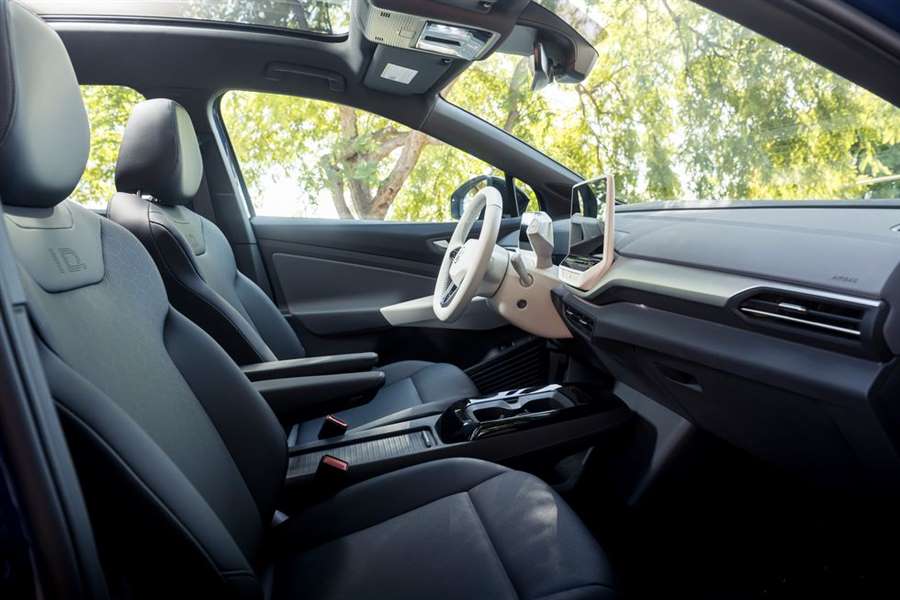
VW also touts ID.4's 201-hp electric motor as having about the same power as the base four-cylinder engines in many compact crossovers. Maybe so, but the ID.4 weighs 4698 pounds. That's a whopping 1000 pounds more than the gas-powered competition. With only 229 pound-feet of torque, the neck-snapping shove of instant torque we like so much in electric cars is largely missing. When merging or passing at highway speeds, the ID.4 feels sluggish. The run to 60 mph takes 7.6 seconds, and the quarter mile is complete in 16.0 seconds at 86 mph, on par with the quicker gasoline models in this segment but significantly slower than similarly sized EVs such as the Ford Mustang Mach-E and Tesla Model Y. A more powerful dual-motor all-wheel-drive version of the ID.4 with around 300 horsepower will be available later this year and will likely bring the ID.4 closer to the snappy acceleration of other EVs.
LOWS: Unexciting to drive, anonymous styling, annoying infotainment.
If you are excited about the handling prospects of this rear-drive configuration, don't be. The ride is pleasingly firm and the steering is appropriately weighted, but there's little verve or joy to the driving dynamics. The ID.4 simply goes where it's pointed without complaining, which, to be fair, is what's expected of a small SUV. We recorded 0.85 g of grip on the skidpad and a stopping distance of 166 feet from 70 mph, average numbers for the class.
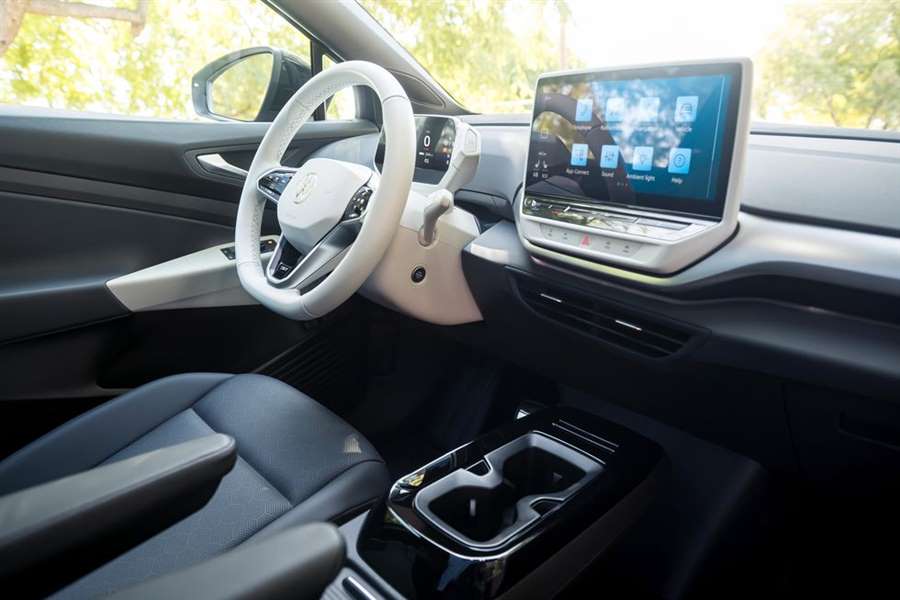
Driving the ID.4 is a largely serene experience. At 70 mph we measured a library-like 68 decibels, and the powertrain remains hushed under acceleration. The interior is airy and spacious, with a low beltline and a generous rear seat. There's no "frunk" as in many other EVs, but the cargo area behind the hatch is big, fitting eight carry-on suitcases with the rear seats up and 26 cases with the seats folded. The front seats are good for hours, and the driving position is natural, with good visibility. Storage cubbies abound, and rear-seat passengers enjoy their own USB ports and air vents.
The least conventional aspect of the ID.4 is the one you'd most hope to follow convention: the user interface. We're not fans of VW's latest infotainment software, which is overly reliant on the 12.0-inch touchscreen and doesn't provide enough physical controls for things you want quick access to such as heated seats and radio tuning. There are touch-sensitive sliders for the climate controls, sunshade, and volume adjustment, and haptic buttons for various menus. Even the few physical controls are strange. There are only two window controls on the driver's door panel, and you must press a finicky haptic switch to activate the rear windows. And the clean look of the white steering wheel isn't going to stay clean for long.
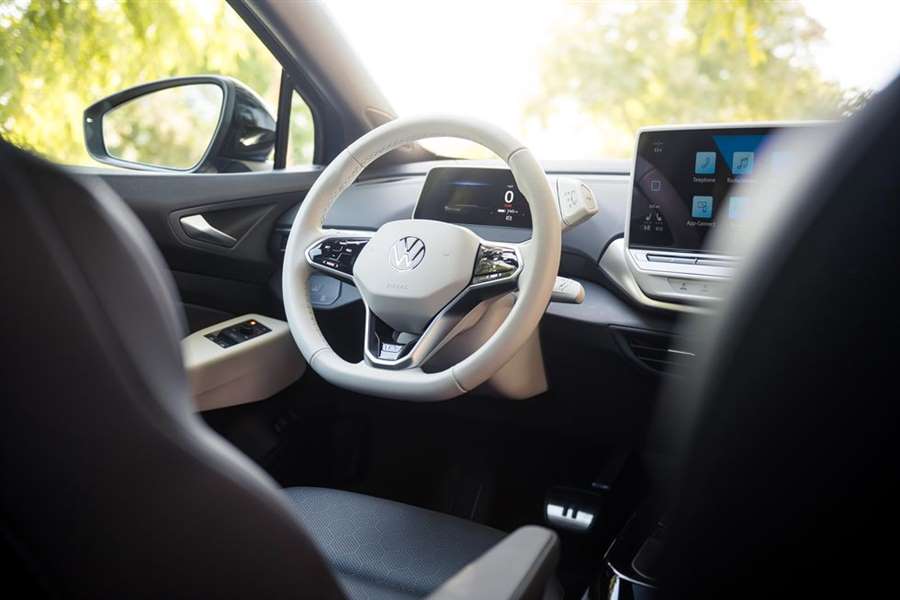
The driving experience in the ID.4 is so normal that it's easy to forget that there's nothing for you at a gas station except Flaming Hot Cheetos. The EPA claims a 250-mile range in combined driving, and we measured 190 miles in our real-world 75-mph highway range test done just above freezing temperatures. (Cold temps negatively impact battery range.) Refilling the VW's battery from empty takes about 7.5 hours on a typical 220V charger, and fast chargers can get you from 5 to 80 percent charge in a claimed 38 minutes. Thanks to Dieselgate, VW is investing heavily in charging infrastructure through its subsidiary, Electrify America. Buyers benefit from the scandal with three years of free charging from Electrify America's fast chargers.
Early adopters of new tech might be disappointed by the ID.4's lack of quirkiness. The ID.4 feels like it's trying to convince buyers that an EV can cost and provide the same experience as mainstream gas-powered vehicles. Pricing starts at $41,190, and our 1st Edition test car stickered for $45,190, which is within reach of loaded gas-powered compact crossovers, especially when you factor in thousands of dollars in federal tax credits.
Rather than an electric vehicle shaped like a compact SUV, this Volkswagen feels like a mainstream crossover that happens to have an electric motor and a battery pack. But the ID.4 lacks any distinct advantages over gas models, and it's missing the cool factor and instant-feeling acceleration of other EVs. VW is so determined to make the ID.4 normal that it seems to have forgotten that EVs can be weird, funky, and fun. The ID.4 is a quiet and comfortable transportation pod that will satisfy buyers looking for a quiet and comfortable transportation pod.
Trick on how to remove dents on the car - repair sheet metal without varnishing!
After we wrote earlier about some tricks for car repair, such as the repair of sheet metal that is performed only with the help of hot water, this time it is a slightly "more serious method"
flattening of sheet metal without varnishing - vacuum repair of sheet metal
The method of leveling the recesses on the car has several, but in all cases the task and goal is always the same, to return the sheet metal / plastic to its original condition, preferably without the need for compensation by a painter (leveling without painting) because quality painting is very expensive. guessing the hue of an existing (faded) color and partial spraying can be a science in themselves.
After all, if you are already interested in one of the DIY (do-it-yourself) methods for repairing bodywork, and you are as soon as you read this, the assumption is that you want to minimize all possible expenses for that repair.
We have already written about the method of straightening with hot water, and about the method with the help of a hair dryer, which also proved to be very reliable, but this time we will also mention vacuum, more precisely vacuum adhesive.
{vembed Y=s2OrKiunneM}
You don't have to be skeptical, because of this picture above, because we all have some other allusions to this device and we think that its place is exclusively in the toilet, but if we tell you that professionals use various similar tools to correct dents, you may still believe that it all really works!
All you have to do is clean the recessed surface, moisten it so that the vacuum adhesive can catch as well as possible, and by pulling the adhesive that holds the sheet metal, you simply return the surface to its original state!
Yes, it really is as simple as it sounds, and for all skeptics, there is also evidence in the form of two videos, so see how you can perform a vacuum body repair yourself!
And you can be creative and use any vacuum holder you have at home, eg various holders for mobile phones, tablets, navigation
A 2021 Honda CR-V Hybrid Sidles into Our Long-Term Fleet
We begin a 40,000-mile shakedown of Honda's first electrified crossover to see if the powertrain scales up into the brand's bestselling vehicle.
Introduction
We invited a 2021 Honda CR-V to join our long-term fleet so we could spend some quality time (and 40,000 miles) with Honda's bestseller and the fifth-bestselling vehicle in the United States. We chose the hybrid because it's new to the lineup and because we liked the 212-hp fuel-sipping powertrain in the Accord. In the CR-V, the system boosts fuel economy and performance, making it the choice for buyers who want efficiency and power. Those customers will have to shell out for it, though, given the CR-V Hybrid sits at the top of the range. In addition to shaking down the powertrain and seeing if it can deliver the promised fuel economy, we're hoping this compact crossover—the brand's first with hybrid power to make it to the U.S.—will give us a glimpse at the future of Honda, which will soon phase out gas-only powertrains in Europe.
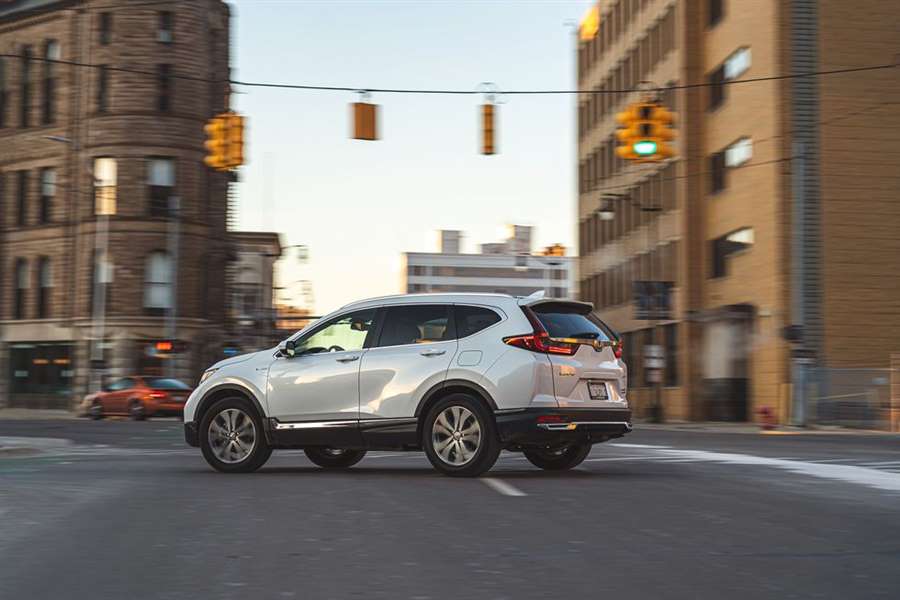
We ordered a top-of-the-line Touring model loaded with just about everything: leather seats (heated up front), navigation, wireless phone charging, Android Auto and Apple CarPlay integration, a nine-speaker audio system, a liftgate that opens when you wave your foot under the bumper, proximity key entry, remote start, the Honda Sensing suite of driver-assistance features, and more. Our $37,920 example has but one option: white paint for $395. Perhaps it's because all of southeast Michigan is currently covered in two feet of snow or because half the vehicles in the grocery-store parking lot are also painted in America's favorite automotive hue (and shaped like tall boxes), but the CR-V blends in a little too well with its surroundings. We wouldn't call the color choice regrettable but maybe a bit forgettable.
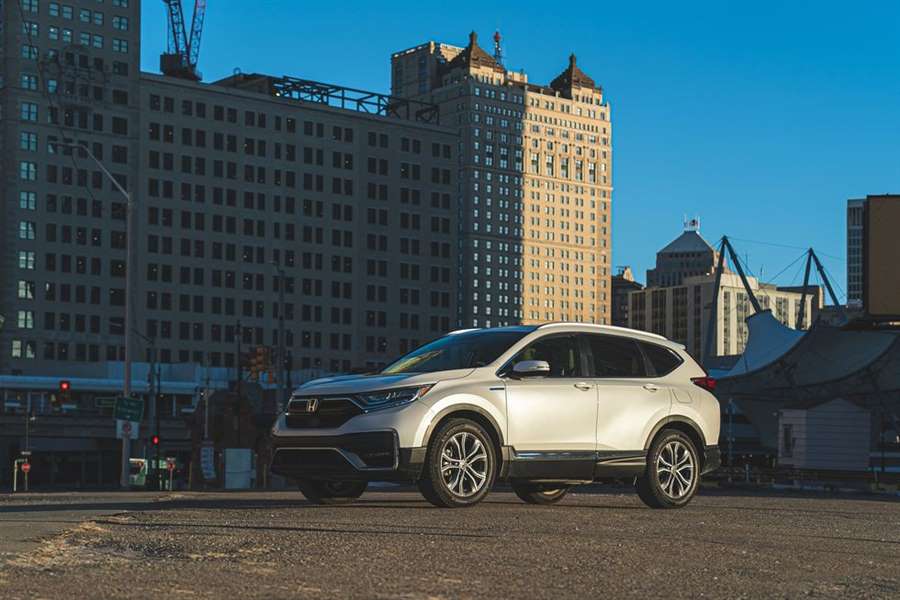
Inside, Honda's inoffensive design, easy-to-use 7.0-inch touchscreen, and highly adjustable center console should satisfy most shoppers in this class if not the nit-pickiest staffers on our masthead. Hybrid versions differ from regular CR-Vs in a few subtle ways. A unitless battery gauge replaces the tachometer in the digital instrument cluster and tells you vaguely how much juice you're using at any given moment. Honda also opted for a push-button transmission instead of the chunky gear lever used in the core model. Staff reaction to push-button shifters is mixed, but the setup at least makes for a tidy, unobtrusive center console. In the same way a light color creates the illusion that a room is larger than it is, the Ivory surfaces in our CR-V make the cabin appear adequately spacious, which, granted, it is, offering 103 cubic feet of passenger volume. Provided that light-beige leather can withstand the dye in our Levis, the simplicity of this interior all but ensures it will age well.
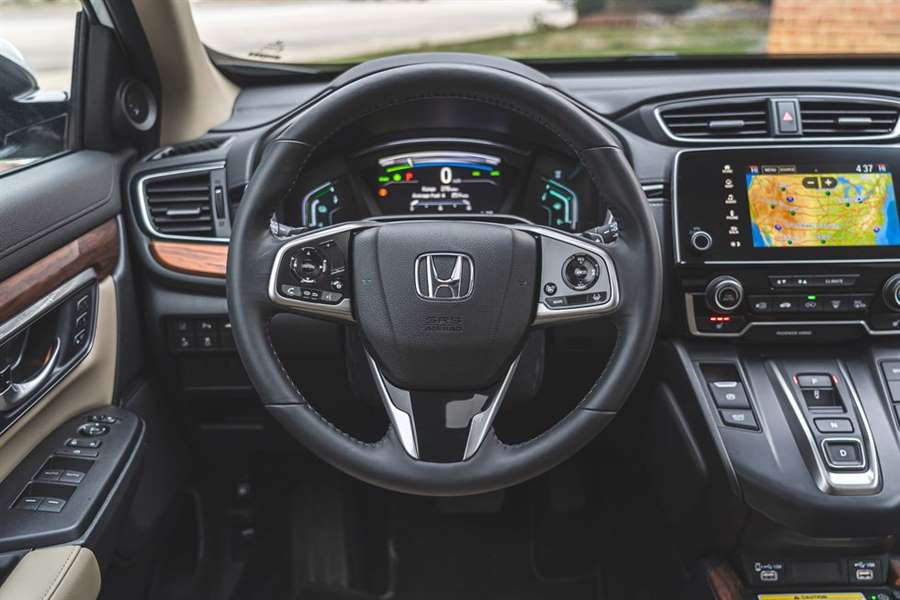
A couple of hybrid caveats to note: Choosing this powertrain nullifies the nonhybrid CR-V's 1500-pound tow rating, so technical editor David Beard will have to look elsewhere when he wants to tow his snowmobile. Which is just as well, considering the cargo hold probably wouldn't fit all of his gear. The gas-electric CR-V sacrifices six cubic feet of cargo space (and its spare tire) to the battery. The upside is that, compared with a regular all-wheel-drive CR-V, you gain 9 mpg in combined driving by the EPA's yardstick. That said, if you drive like we do, you can expect much worse results: We're currently averaging a mere 27 mpg.
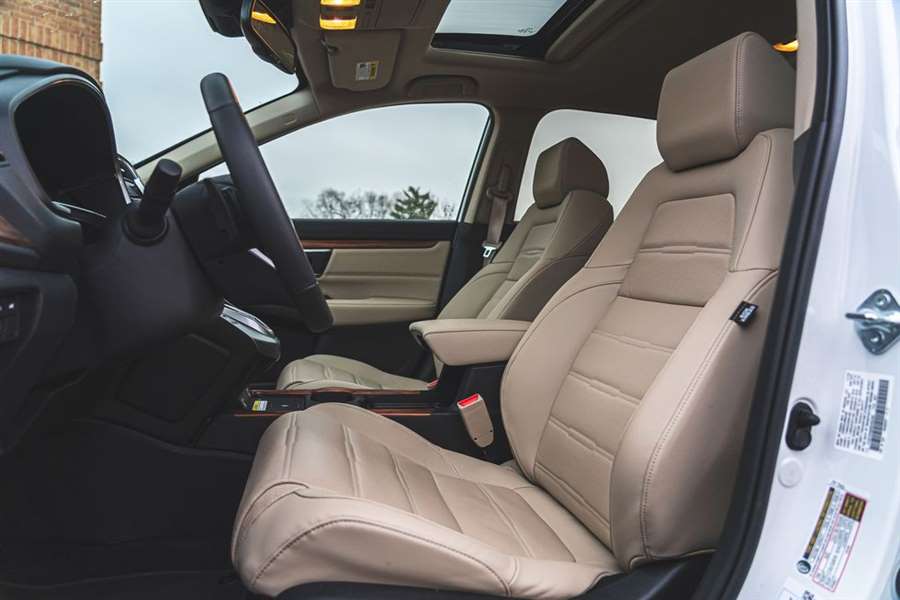
The Honda's road manners are in line with the amiable-but-boring norm of the segment. Its smooth ride and secure handling are immediately apparent, but there's nothing here that'll make an enthusiast grin—unless of course you're reading its VIN, which by dumb luck contains a bit of bathroom humor. Floor the accelerator and the powertrain fills the cabin with 75 decibels of sound. That's quieter than the regular CR-V's 78-decibel moan at full throttle.
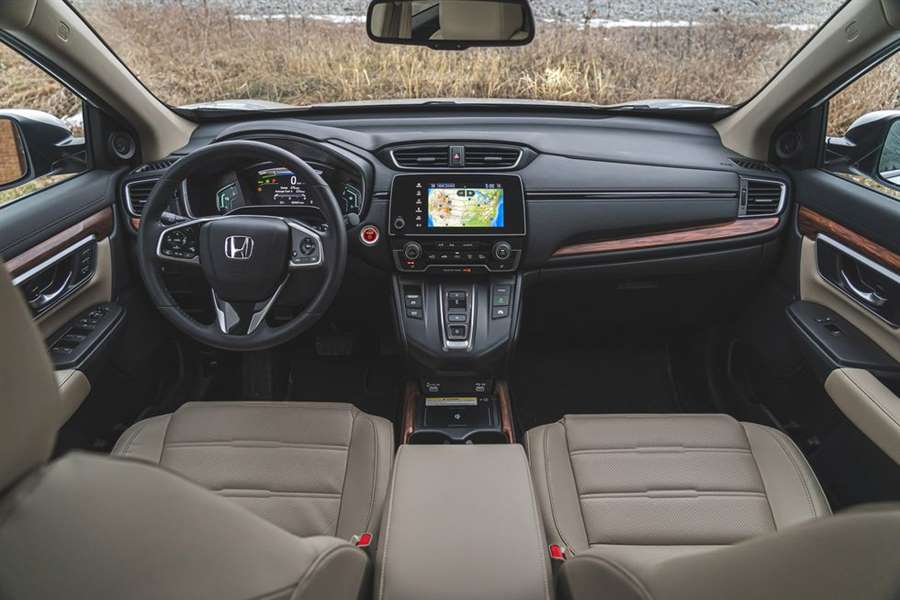
Due to COVID-19 restrictions, we haven't had as many butts in these seats as we'd like, but after soft-shoeing it through the break-in period, we sent the Honda to the test track. The hybrid's drive motor can contribute 232 pound-feet of torque from the get-go, which helps this ute reach 60 mph a tenth of a second quicker than the unelectrified model, but the latter catches up by 70 mph and pips the hybrid at the quarter-mile, 15.9 seconds to 16.1. Our long-termer also lagged behind the regular CR-V in braking (170 feet versus 165) and roadholding (0.80 g versus 0.85). Given both cars wear identical Continental CrossContact LX Sport tires, we suspect the hybrid's extra 190 pounds are primarily to blame. Fortunately, in the real world, this CR-V seems more athletic than the gas-only version, and its quicker 5-to-60-mph time bears that out. As we put more miles on the odometer, we hope to see some of these numbers improve—particularly the observed fuel economy.
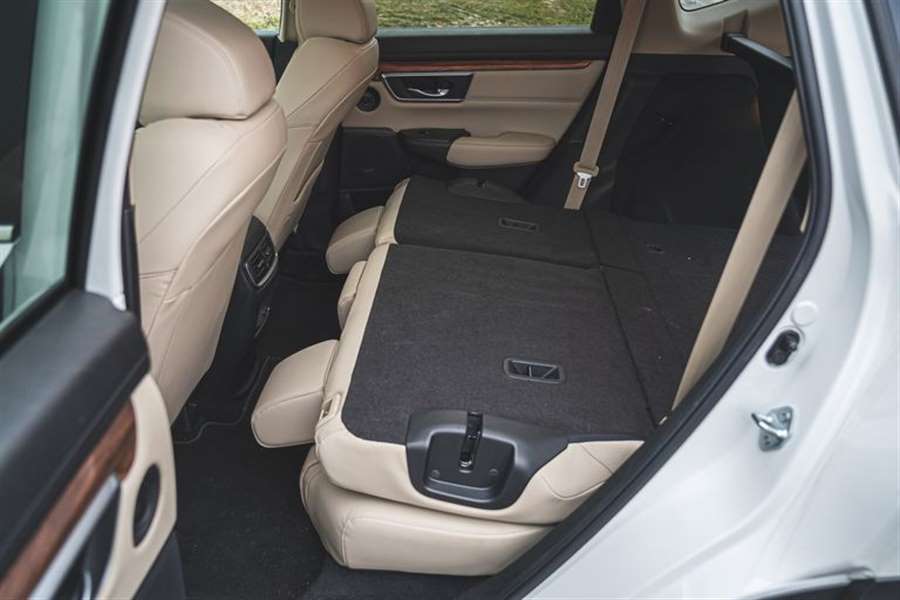
Months in Fleet: 2 months Current Mileage: 5131 miles
Average Fuel Economy: 27 mpg
Fuel Tank Size: 14.0 gal Observed Fuel Range: 370 miles
Service: $0 Normal Wear: $0 Repair: $0
Damage and Destruction: $0
This is a new sign that will adorn Peugeot cars
Peugeot is one of the oldest active car brands, which since 1850 has been adorned with a coat of arms decorated with a lava head. Now the French brand has introduced the eleventh evolution of its logo.
After a complete redesign of its vehicles over the past 10 years, Peugoet has also redesigned its logo. The new modern and elegant coat of arms was created by Peugeot Design Lab, the global design studio of this brand.
In early 2021, with the launch of the range that will introduce the new Peugoet 308 with new websites and the establishment of the Stellantis groups with Fiat-Chrysler, the stars have aligned.
During the year of business, Peugoet has experienced all the revolutions: industrial, technological, political, social, digital and, now, the environmental revolution - energy transition and carbon dioxide-free mobility in the brand's central strategy for a sustainable future.
In the last 10 years, the entire range has undergone a reversal. And this is what has been achieved: "International Van of the Year" with Peugeot e-Expert 2021 and Partner 2019 and three "Cars of the Year" (Peugeot 308, chosen in 2014, Peugeot 3008, chosen in 2017 and Peugeot 208, selected 2020). And above all, an electrified range for both passenger and light commercial vehicles.
The new logo represents what Peugeot meant yesterday, what it means today and what it will mean tomorrow.
It is synonymous with prestige, self-confidence, longevity and lineage. With it and its new visual identities, Peugeot joins history and hypermodernity. With this coat of arms, the Peugeot brand sets out to conquer new countries, accelerate international growth, perform French style and knowledge, as well as French elegance.



